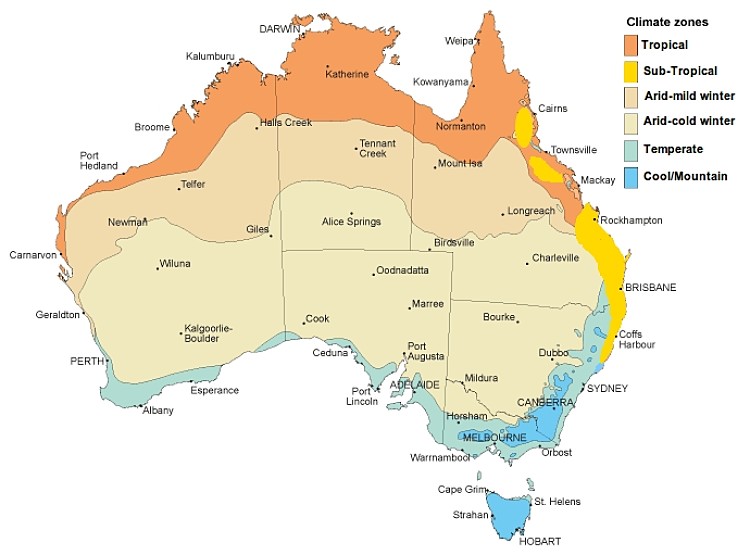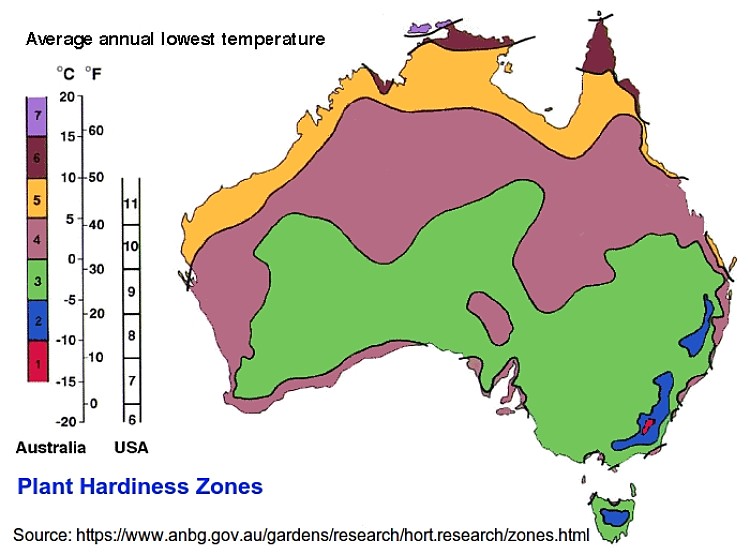Vegetables to Plant in Australian Regions
Scroll to Map & DescriptionsSelect your Australian Climatic Region
Arid Zone Cool/Mountain Zone Temperate Zone Sub-tropical Zone Tropical Zoneor Select your City or Town Nearby
- Adaminaby
- Adelaide
- Albany
- Albury
- Alice Springs
- Atherton
- Bairnsdale
- Ballarat
- Ballina
- Batemans Bay
- Bathurst
- Bendigo
- Birdsville
- Bomaderry
- Bombala
- Boulder
- Bourke
- Bowral
- Bright
- Brisbane
- Broken Hill
- Broome
- Bunbury
- Bundaberg
- Burnie
- Busselton
- Byron Bay
- Cairns
- Camden Haven
- Canberra
- Cape Grim
- Carnarvon
- Ceduna
- Charleville
- Coffs Harbour
- Colac
- Darwin
- Devonport
- Dubbo
- Echuca
- Eden
- Emerald
- Esperance
- Forster
- Geelong
- Geraldton
- Giles
- Gladstone
- Gold Coast
- Goolwa
- Goulburn
- Grafton
- Griffith
- Gympie
- Halls Creek
- Hervey Bay
- Hobart
- Horsham
- Jindabyne
- Kalumburu
- Kalgoorlie
- Karratha
- Katherine
- Kempsey
- Kingaroy
- Launceston
- Lismore
- Lithgow
- Mackay
- Maitland
- Mareeba
- Marree
- Maryborough
- Melbourne
- Mildura
- Mittagong
- Moama
- Moe
- Mooroopna
- Morisset
- Morwell
- Mount Gambier
- Mount Isa
- Mudgee
- Murray Bridge
- Muswellbrook
- Nelson Bay
- Newcastle
- Newman
- Normanton
- Nowra
- Oodnadatta
- Orange
- Orbost
- Parkes
- Perth
- Port Augusta
- Port Hedland
- Port Lincoln
- Port Macquarie
- Port Pirie
- Portland
- Ravenshoe
- Queanbeyan
- Rockhampton
- Sale
- Sanctuary Point
- Shepparton
- Singleton
- St George
- St Helens
- Stanthorpe
- Strahan
- Sunshine Coast
- Swan Hill
- Sydney
- Tamworth
- Taree
- Telfer
- Tennant Creek
- Toowoomba
- Townsville
- Traralgon
- Tumut
- Tuncurry
- Tweed Heads
- Ulladulla
- Ulverstone
- Victor Harbor
- Wagga Wagga
- Wangaratta
- Warragul
- Warrnambool
- Warwick
- Weipa
- Wentworth
- Whyalla
- Wiluna
- Wodonga
- Wollongong
- Wynyard
- Yeppoon
Australian Climate Zone Map

Australian Climate Zone Descriptions
Arid Zone
The Arid zone occupies the dry heartlands of Australia from coastal Western Australia between Geraldton and Carnarvon to the areas west of the Great Dividing Range, inland from Sydney and Brisbane in the East. It includes all the desert areas around Kalgoorlie, Alice Springs, Birdsville and Bourke. It includes all the dry inland areas of Queensland, Northern Territory and Western Australia. The area can be divided into a northern arid zone with mild winters and a southern zone with cold winter temperatures. The inland arid region in Australia, even if water, apart from rain, is available. There are very high summer temperatures; extremely high evaporation rates. A long dry summer with very little rain is common. The southern areas can be quite cold in winter, average annual minimum temperature of -5°C, with some frosts. It pays to install shade cloth over your garden to reduce the extreme temperatures. A ready supply of artificial water, from bores or other sources, is also essential. Towns include: Albury, Alice Springs, Geraldton, Griffith, Port Augusta, St George.
Cool/Mountain Zone
The Cool/Mountain Zone has mild or warm summers, but cold winters with frosts from June to September. Unexpected late frosts can be a major problem for gardeners in these areas. This zone includes higher elevation areas of the Northern Tablelands of NSW (around towns such as Armidale, Guyra and Glen Innes). It also includes much of the Southern Tablelands (around towns such as Bowral and Goulburn) and the Australian Highlands and Alps in the Snowy Mountains of NSW and Victoria. It also includes Canberra and the ACT, and most of Tasmania (except for the northern coastline and the Bass Strait Island. It also including the Granite Belt of South East Queensland famous for its wine and fruit.
These cool zones have cold winter temperatures with heavy frosts during the cooler months. In most areas, apart from the high alpine areas of the Snowy Mountains, summers are warm and mild. Average annual minimum temperature range from -5°C to 0°C. Alpine areas also have snow which can cover the ground from June to August. The the winter chill factor is an advantage for growing fruit trees such as cherries that need a significant winter chill to flower successfully. However, summer growing season is short and so getting seeds to start early in a greenhouse or indoors can be an advantage. Covering vulnerable seedlings such as tomatoes is also a good idea. Towns include: Bright, Burnie, Canberra, Goulburn, Hobart, Strahan, Tumut
Temperate Zone
The Australian Temperate Zone features warm summers (average January maximum < 30 degrees C) and mild or cool winters. This area includes the hinterland areas in the Great Dividing Range in southern Queensland and the New South Wales tablelands. It also includes the lowland coastal regions south of Sydney. Added to this are areas along the entire southern coastline of Australia, from Melbourne through to Adelaide and on through to Perth.
Temperate zones generally have four the distinct seasons. Where frost occurs it is generally light and short-lived. Frost can help to sweeten certain vegetables such as parsnips and cabbage. A winter chill can also allows successful growing of fruit trees and vegetables that require a chill. Watch the weather forecasts and be prepared to cover sensitive seedlings in Spring and early summer. Towns include: Adelaide, Albany, Geelong, Melbourne, Sydney, Tamworth, Wollongong
Sub-tropical Zone
The Sub-tropical Zone has Warm humid summers (average January maximum temperatures generally less than 30 degrees C). The winters are mild and dry with no frosts. This zone includes the eastern seaboard of Australian from Coffs Harbor and Byron bay in NSW, into Queensland from Brisbane to Rockhampton. It also includes the hinterland areas on the hills inland from Cairns and Townsville, in Queensland. Coastal areas of Western Australia can also be included in from Geraldton to Canarvon, though this is a very narrow strip.
The climate is mild throughout the year with a low winter rainfall and generally reliable summer rainfall. These conditions are ideal for growing most vegetables. There can be high humidity from November to March. Frosts are very rare and average annual minimum temperatures are around 10°C. Average January maximum temperature less than 30°C and there is generally plenty of rain in summer. Despite the warm temperatures, you can still grow 'Temperate-style' vegetables in winter. Gardeners here switch to planting tropical vegetables in Spring to grow over the warm wet summer season. The subtropics is ideally suited for growing tubers like sweet potato, cassava, Queensland arrowroot, yacon and jicama. There is a wide range of vegetables that can be grown all-year-round that would only grow as summer crops in Temperate areas. Towns include: Atherton, Brisbane, Coffs Harbour, Gold Coast, Hervey Bay, Sunshine Coast
Tropical Zone
The Tropical Zone has very hot and humid summers (average January maximum temperature > 30 degrees C), often with a summer wet season. Winters are also warm and often dry. The Tropical Zone extends right across northern Australia from Carnarvon in Western Australia, north through Port Hedland, Broome, Darwin, Cairns, and south down the Queensland coast Rockhampton.
The key features of this zone are high temperatures throughout the year with no frost. The average annual minimum temperature is around 15 degrees C. The distinctive feature is the monsoon or 'wet season' in summer and 'dry season' in winter. The wet season is very humid and hot with an average January maximum temperature greater than 30 degrees C. Towns include: Broome, Bundaberg, Cairns, Darwin, Townsville
Plant Hardiness Zones for Australia
Several people have developed Plant Hardiness Zones for Australia based on the USDA classification. See the map below developed by the Australian Botanical Gardens.

All of Australia (excluding Macquarie Island) is covered by just over four US zones (7b to 11).
As might be expected, the main factors determining average minimum temperature are altitude, latitude and proximity to the coast.
Zone 1 - includes the alpine/mountainous areas in South Eastern Australia.
Zone 2 - includes the tablelands of New South Wales, South East Queensland and Victoria. It also the upland areas of central Tasmania.
Zone 3 - includes most of the southern part of the continent, with the exception of localities near the coast, due to maritime influences.
Zone 4 - includes a broad band right across the continent from coastal Queensland to Geraldton and Shark Bay in WA. It also includes the Mornington Peninsula, as well as areas adjacent to Adelaide and Spencer Gulf. It also includes the south western coastal areas along the Great Australian Bight. Sydney and the north coast of NSW are included, and a sprinkling of many localities dotted along the southern coast of Australia.
Zone 5 - includes some parts of the Queensland coast, parts of Western Australia, north of Shark Bay and a band across the top end of Australia.
Zone 6 - includes the Queensland coastline north of Cairns, Cape York Peninsula and the coast of the Northern Territory.
Zone 7 - includes several islands off the north coast.
Disclaimer: The PlantWhatWhen vegetable planting guide is only designed for use as a very general reference for home gardening purposes. It is not to be used for farming, markets or commercial activities of any kind whatsoever. We take absolutely no responsibility for the accuracy and adequacy of the information provided on this site. We recommend that you consider your local climate, weather patterns and conditions when deciding what and when to plant in your home garden. It's entirely your own decision. Happy Gardening and Best Wishes!